|
However, many problems start to occur when the elderly population increases to this extent. The first patrol car appeared in Tokyo in 1950. Arrival of a full-scale motorized society is a very new phenomenon. Driving by the elderly is accompanied by a very difficult problem. I think many of you here own a driving license but the big question would be the age to which people should be allowed to drive. I am a little worried what would happen when the streets become full of elderly drivers, as is expected to occur quite soon in the early part of this century. (Fig(6))
| (拡大画面:45KB) |
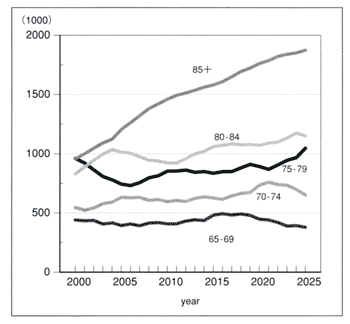 |
Fig(6)
Then we have the problem of the higher percentage of women among the elderly. The number of women among the population aged 65 years and above is starting to exceed that of men at a striking rate. This figure shows that grandmothers aged 85 years and above are going to increase at an overwhelming rate in the population bracket aged 65 years and above. There will be a problem of who is going to look after this age group. Senile dementia develops at very high rates at ages 85 years and above. That is why senile dementia will become a big problem and will turn into an overriding predicament unless some measures are taken against it.
Then we have the problem of who would be looking after these demented and bedridden elderly. If you conduct a survey on this topic with married couples, most husbands say that their wife would take care of them, while wives assign this role to their daughters. This is because women are smart and know that they would outlive their husbands. However, there is a question as to whether they could actually rely on their children.
It is indicated here in the following five figures. These figures were obtained by dividing the number of women of ages 40 through 59 by the number of the elderly of ages 65 through 84. I'm not suggesting that women should look after the elderly by any means. I prepared these figures simply based on the present situation where women are playing the central role in caring for the elderly in approximately 90 percent of such cases. I am not by any means affirming this situation. I am only trying to explain what would happen if the present situation continued. I would like to stress that it is outside of my value judgment. I say this at the outset because I've been criticised by a newspaper about this once.
(Fig(7)) (Fig(8)) (Fig(9)) (Fig(10)) (Fig(11))
| (拡大画面:68KB) |
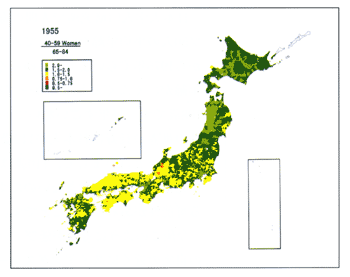 |
Fig(7)
| (拡大画面:53KB) |
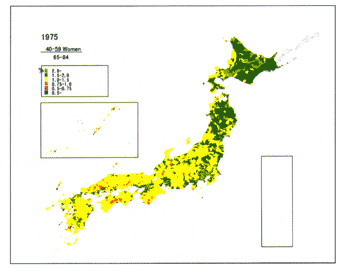 |
Fig(8)
| (拡大画面:45KB) |
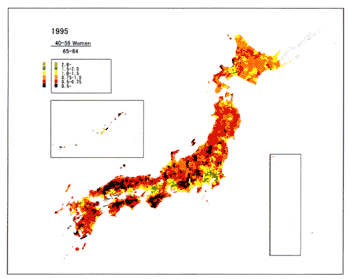 |
Fig(9)
| (拡大画面:47KB) |
 |
Fig(10)
| (拡大画面:48KB) |
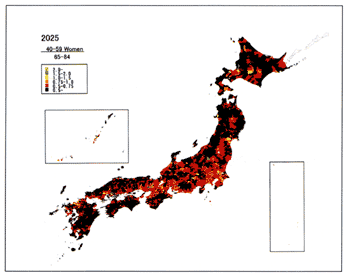 |
Fig(11)
There are approximately 3,300 municipalities in Japan. Plotted on a map, yellow points were dominant in 1955. A yellow point means there were two persons to take care of each elderly person in a particular municipality. The nursing population was twice as large as patient population. Those were the good days. Green points started to increase in 1975 and the dominant colour had changed to red by 1995. Red is bad news. A red point stands for less than 1 person, meaning 0.05. This translates to two elderly persons for every caretaker. The points will change to black in 2010. At a village in Kumamoto Prefecture, there are 100 elderly persons for every five potential caregivers. This prediction will come true with near-certainty. The supporting capacity of the family is clearly limited throughout Japan and will reach the world's lowest level in 2005.
Nursing care insurance is being created under these circumstances, but a concern exists that there won't be enough people to look after the elderly. How the government is going to maintain this system will become an important issue in the future.
How far can we go in terms of financing? This table (relevant table omitted*) shows the financial crises that have occurred around the world over time. This is the extent of the Japanese government's financial crisis in 2000. These figures represent the number of years it would take to pay back this debt with taxes. Japan needs 15 years. It takes Japan 15 years to pay back this debt if the entire tax revenue of the country is spent on paying back the debt and not spending a cent on anything else. It is a colossal amount. Italy was once said to be experiencing a serious crisis among the EU countries, but the amount was only this much. I think you can understand the magnitude of the financial crisis in Japan today.
Let us divide the amount further to see it on an individual level. When applied to your households, it means that you have an average monthly income of 574,676 yen, of which you send 170,000 yen to your relatives in your home town (central government's subsidy to local governments), pay 180,000 yen to pay back the loan (government bond) and spend 510,000 yen as living expenses. It means that you are 290,000 yen short every month and that you have a home mortgage of nearly 50 million yen on top of that.
This is the reality Japan is currently in, and we have to somehow pull our country together. How we overcome this is a major problem.
I don't want you to think I am an outrageous guy that tells people these horrible stories all the time, so I will offer you some choices we have for solving the problem. First, we could change the definition of "elderly". This has been initially proposed by Dr. Kuroda. Elderly persons account for only 17 percent of the population today. What we need to do is create a society in which only 17 percent of the oldest segment of the population qualify as the "elderly population". To do that, all you need to do is gradually raise the definition of the elderly over the next 25 years to "those aged 75 years and above". You can adjust everything including employees' pensions and the age of retirement accordingly.
Another idea is to approach the issue from a completely different point of view and introduce a health hierarchy system. This would require help from the medical community but what we do is select several indices for determining the health of individuals and start the payment of pension to those individuals in accordance with their health status.
Healthy people would continue to work instead of collecting pension. Dr. Kuroda, for example, is so healthy that he has no need to be on pension. I think we have a choice of creating such a society.
Many people in Japanese society see elderly people as a burden. I personally consider this to be a very unfortunate situation, and feel that the key lies in creating a society that sees the elderly as growing asset. It would be important to carry out social engineering for this purpose.
I had an opportunity after being in the same session at a population conference in the U.S. to talk with Professor Walt Rostow, who served as President Kennedy's economic advisor. As you may know, Professor Rostow coined the term "economic takeoff". The paper he presented at this conference was very interesting. It was entitled "Japan's Fourth Challenge". The first challenge came in the 1600s when three generations of the Tokugawa Shogunate closed the country to foreign commerce. The second challenge was the Meiji Restoration, in which prominent statesmen of the Meiji era demonstrated tremendous leadership in modernizing Japan and adapting Western ideas and lifestyle. The third challenge was the reconstruction of the country after World War II.
And then Professor Rostow said that the falling birth rate and aging population is the fourth challenge for Japan. Wonderful political leadership was demonstrated in Japan in the past three occasions to overcome the challenge. Therefore, the extent of leadership demonstrated by politicians would have a very important impact in whether the country could overcome this fourth challenge.
Efforts on both the macro-economic and micro level are important, but I think that what Japan really needs now is political leadership that could generate a long-term and stable outlook for the country.
Thank you.
|